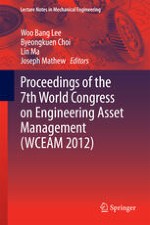These proceedings comprise 60 refereed papers of the Seventh World Congress on Engineering Asset Management (WCEAM) that was held in Deajeon City, Korea from 8-9 October 2012. The material is a compilation of state-of-the-art papers in the field covering a comprehensive range of subjects that are equally relevant to business managers and engineering professionals alike.
Proceedings of the 7th World Congress on Engineering Asset Management (WCEAM 2012): Towards Integration and Interoperability in EAM covers a wide range of topics in the discipline of engineering asset management, including:
· strategic asset management
· condition monitoring and diagnostics
· integrated intelligent maintenance
· sensors and devices
· information quality & management;
· sustainability in asset management
· asset performance and knowledge management
· data mining and AI techniques in asset management
· engineering standards and
· education in engineering asset management.
The breadth and depth of these proceedings will make them an excellent resource for asset management practitioners, researchers and academics, as well as undergraduate and postgraduate students in tertiary institutions and in industry.
